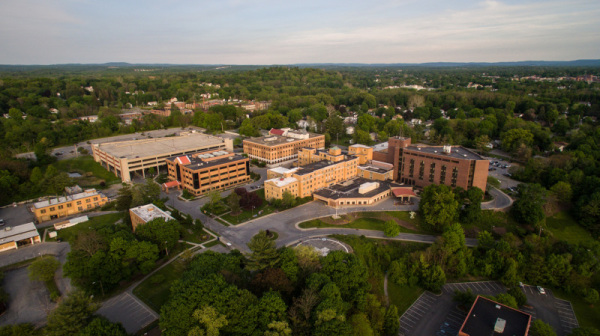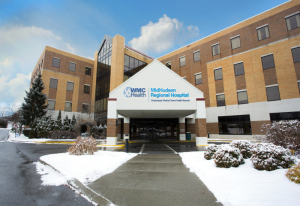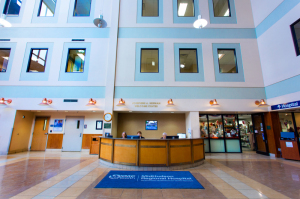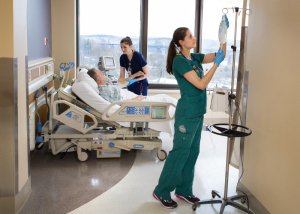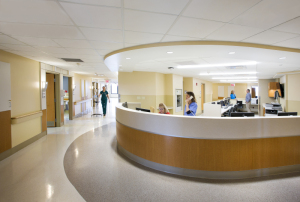Q&A with Paul S. Hochenberg, executive director for MidHudson Regional
May 11, 2018
by Sean Ruck, Contributing Editor
HealthCare Business News recently spoke with Paul Hochenberg, executive director for MidHudson Regional Hospital, a member of the Westchester Medical Center Health Network (WMCHealth), to learn more about the relatively new hospital that has existed, in a way, for more than a century.
HCB News: How long have you been with the Westchester Medical Center Health Network?
Paul S. Hochenberg: I’ve been with the WMCHealth network for 12 years in May, holding senior administrative positions and starting in Valhalla. For the past almost four years, I’ve been at MidHudson Regional Hospital.
HCB News: What drew you to a career in healthcare?
PH: I guess years ago I was intrigued by the marriage of healthcare and business acumen. I entered into the field 45 years ago. At that point, there were very few programs for healthcare executives, so I got in, I guess you can say, in the infancy stage of the healthcare business. It was intriguing to me to be able to apply business principles to hospitals and healthcare.
HCB News: MidHudson operated as St. Francis Hospital for just over a century . . .
PH: Yes, that’s right. One hundred years and then St. Francis Hospital became a part of WMCHealth in May of 2014. It was a very strong Catholic institution in the region for many years, and the Sisters of St. Francis were the controlling entity. When it became part of WMCHealth, it was renamed and MidHudson Regional was born. And we certainly have a rich history our hospital is based on. One hundred years as St. Francis, and we’re coming up on five years as part of WMCHealth.
HCB News: Some healthcare networks designate certain roles/specialties to each facility, while others assign regions to each facility. What kind of structure does MidHudson Regional fit into?
PH: MidHudson Regional Hospital is part of the “Northern” regional strategy. WMCHealth is very large now, with 10 hospitals, the flagship institutes being Westchester Medical Center and the Maria Fareri Children’s Hospital in what we call our Southern Region, closest to New York City. There are various hospitals in various regions, spanning eight counties north of New York City. Bon Secours, the three-hospital charity system, is in the West; there are four hospitals in the Northern Region, which would be MidHudson Regional and three hospitals within HealthAlliance of the Hudson Valley. So we’re working collegially on clinical integration in the North. I’m working with my colleagues, and staff is working together, to look at the clinical implications of providing care to the region under the umbrella of WMCHealth.
HCB News: What draws people to work at MidHudson Regional?
PH: I’m a firm believer that human capital is our greatest asset. So I think it’s the people that make the institution great, not necessarily the bricks and mortar, although we’ve invested a lot on the structure, certainly. When I got here, a little over three years ago, I met people who have been here for 35 and 40 years. That’s the strength of the institution. It’s the fabric that binds the institution together. We have over 1,400 people working in one capacity or another. We have over 350 physicians affiliated with the hospital. There’s no substitution for human capital when dealing with people’s lives.
HCB News: What attracts patients?
PH: I make a lot of rounds and I’m very active in the community. I think it’s important when you’re running a community hospital to be sensitive to the needs of that community. I quite often see people coming in and recognizing their mothers, fathers, sisters, neighbors… I think it drives home the fact that you’re not just a name and number, but you’re an individual, being cared for as an individual, in a very personalized way. I think that’s the beauty of this institution.
HCB News: Can you give a rough idea of the patient-insurer breakout regarding private insurers or public?
PH: We have private, self-pay and commercial insurance. Medicare and Medicaid, too. We provide care for anyone coming into the emergency room, regardless of ability to pay. We have an active emergency room and we also have a strong commitment to provide behavioral health services to the community. That’s often a forgotten, second-tier focus, but we believe it’s incredibly important to provide both addiction services and behavioral health services.
HCB News: You’ve teamed with the Dutchess County Stabilization Center to battle substance abuse. The opioid epidemic has received a lot of attention in the past few years. Was that the catalyst, and have you seen a serious uptick of that problem in your area?
PH: We have, and we’ve been providing those services in our area for some time. As a matter of fact, today we have an opioid conference going on in our conference center downstairs. We’ve also just dedicated and renamed our long-standing Turning Point Program the Kyle Goldberg Turning Point Program, after a benefactor who’s had substance abuse touch his family. It continues to be an issue we want to address. We have partnered to provide the most appropriate level of care for patients seeking care. We’ve collaborated, with Dutchess County in the stabilization center, to get people the care that they need without having to put a strain on the Emergency Department services, which should be reserved for acutely ill and injured patients. So we’re providing some hospital staff to the county stabilization center, where patients can be seen and evaluated at the appropriate level. We’re lucky that the stabilization center is just down the road from our ER.
HCB News: The “fast facts” about the hospital mentioned substantial investment in the physical infrastructure. I know there was an $8 million renovation of your medical surgical unit in the Cooke Building. Is there anything else currently in the works or planned?
PH: We’re planning to continue the internal renovation of the inpatient medical units, and we’ll continue as capital funds become available. We believe the institution will look very similar from the outside looking in but will look very different from the inside looking out. We’re providing amenities that enhance the experience for patients coming here. Over the past four years, WMCHealth has invested tens of millions in the infrastructure, advanced clinical equipment and technology, and the all-new inpatient care area. A lot has occurred here in a very brief period of time.
HCB News: Another noteworthy distinction is the extensive telemedicine program under WMCHealth. In a way, it seems like a supplement to your workforce. Does that supplement come with a cost — either per use or monthly — or is it all held within the WMCHealth overall budget?
PH: It’s within the WMCHealth overall budget, and I think it’s a significant technological improvement. We want to make sure patients understand that they can get advanced personalized care and continuous clinical monitoring from WMCHealth specialists miles away through a telemonitor, but that it’s a supplement to their care, not a replacement of the quality care they get from the dedicated healthcare teams here at MidHudson Regional. It’s another level of security that patients should feel comfortable, knowing that they’re monitored 24/7.
It’s additive rather than a replacement. WMCHealth has made a significant investment in telemedicine. Patients have benefited from this. We have it in our ICUs and behavioral health. Advances are being made all the time. I think we were the first hospital in New York State to be able to implement telemedicine in behavioral health.
HCB News: Telehealth has been lauded as a potential way to improve value-based and outcome-based healthcare. Have you seen it paying off in that way?
PH: Yes we have. We monitor outcomes on a regular basis, and the numbers indicate that we’re providing some of the best care and outcomes in the region. Everything is data-driven. We’ve noticed that, and it’s reported out at our quality committee on a regular basis.
HCB News: What are the biggest challenges for MidHudson Regional?
PH: I think it’s very important to take advantage of advances in clinical care delivery. This involves making a significant commitment to capital investments. For instance, acquiring robotic surgical units that will enhance outcomes with less pain, faster recovery, and shorter stay. We’re continuing to make those types of advances. It’s something we’re very sensitive to and interested in providing. We also work to improve staff skills to train for the future.
HCB News: What do you think are the biggest challenges for healthcare in America overall?
PH: It depends if you look philosophically or objectively. I’ve worked in healthcare for 45 years. In my opinion, I think there’s a change underway that’s very rapid. There will continue to be a growth of out-of-hospital care. Home care programs are very important and become more important as the years pass. Length of stay has dropped significantly over the past 10 years at hospitals, and the next step is to have fewer patients overall with a hospital stay, leaving that only for the most ill patients. Mergers and consolidations at the national level will shape things as well. CVS and Aetna, Walmart and Humana — these are the types of consolidations that will likely change healthcare as we know it. For us, we have changed dramatically. The Westchester Medical Center Health Network (WMCHealth) is a 1,700-bed healthcare system headquartered in Valhalla, New York, with 10 hospitals on eight campuses spanning 6,200 square miles of the Hudson Valley. WMCHealth employs more than 12,000 people and has nearly 3,000 attending physicians. From Level 1, Level 2 and Pediatric Trauma Centers, the region’s only acute care children’s hospital, an academic medical center, several community hospitals, dozens of specialized institutes and centers, skilled nursing, assisted living facilities, homecare services and one of the largest mental health systems in New York State, today WMCHealth is the pre-eminent provider of integrated healthcare in the Hudson Valley.
MidHudson Regional Hospital
Location: Poughkeepsie, New York
Year founded: 2014 (previously Saint Francis Hospital, founded in 1914)
Number of beds: 243
Number of employees: 1200
President or Head Executive’s name and title: Paul Hochenberg, Executive Director
Noteworthy distinctions:
MidHudson Regional Hospital, Regional Hospital, a member of the Westchester Medical Center Health Network (WMCHealth), is home to the area’s first and only Level II Trauma Center verified by the American College of Surgeons (ACS). The George T. Whalen Family Trauma Center received this prestigious designation after passing rigorous scrutiny, confirming it provides the very best care to patients needing the most complex, lifesaving treatment. An on-site helicopter pad enables trauma patients to be airlifted from accident scenes directly to MidHudson Regional Hospital for timely, expert care, or when necessary, to be quickly transported to the ACS-verified Level I trauma centers at Westchester Medical Center or Maria Fareri Children’s Hospital in Westchester County.
The expert trauma care available at MidHudson Regional Hospital also is provided by the Emergency Department. The James J. McCann Emergency Care Center is powered by highly skilled physicians, nurses, clinicians and technology. It offers the community the best in emergency medicine with average wait times far below state and national averages. The Fast Track program ensures that most patients with minor injuries will see a healthcare provider in 30 minutes or fewer.
Specialties: Trauma; Stroke; Heart and Vascular Institute; Surgery: Breast, General, Neuro, Oncology, Orthopedic, Thoracic, Vascular, Cancer Care.
Recent developments:
MidHudson Regional Hospital’s most recent purchase was MAKOplasty total knee replacement technology. The first such knee replacement in the area using this sophisticated technology was performed at MidHudson Regional Hospital. The addition of the MAKO enhances an already robust suite of minimally invasive robotics that includes the da Vinci Surgical System.
MidHudson Regional Hospital’s latest infrastructure investment is the $8 million renovation of its medical-surgical unit in its six-story Cooke Building. This all-new patient area fuses emerging technologies and conveniences with an enhanced, reimagined experience for patients, visitors, and caregivers. The innovative renovation, with upgraded patient rooms and the latest technologies, is the optimal environment to offer the best in patient care.
HCB News: How long have you been with the Westchester Medical Center Health Network?
Paul S. Hochenberg: I’ve been with the WMCHealth network for 12 years in May, holding senior administrative positions and starting in Valhalla. For the past almost four years, I’ve been at MidHudson Regional Hospital.
HCB News: What drew you to a career in healthcare?
PH: I guess years ago I was intrigued by the marriage of healthcare and business acumen. I entered into the field 45 years ago. At that point, there were very few programs for healthcare executives, so I got in, I guess you can say, in the infancy stage of the healthcare business. It was intriguing to me to be able to apply business principles to hospitals and healthcare.
HCB News: MidHudson operated as St. Francis Hospital for just over a century . . .
PH: Yes, that’s right. One hundred years and then St. Francis Hospital became a part of WMCHealth in May of 2014. It was a very strong Catholic institution in the region for many years, and the Sisters of St. Francis were the controlling entity. When it became part of WMCHealth, it was renamed and MidHudson Regional was born. And we certainly have a rich history our hospital is based on. One hundred years as St. Francis, and we’re coming up on five years as part of WMCHealth.
HCB News: Some healthcare networks designate certain roles/specialties to each facility, while others assign regions to each facility. What kind of structure does MidHudson Regional fit into?
PH: MidHudson Regional Hospital is part of the “Northern” regional strategy. WMCHealth is very large now, with 10 hospitals, the flagship institutes being Westchester Medical Center and the Maria Fareri Children’s Hospital in what we call our Southern Region, closest to New York City. There are various hospitals in various regions, spanning eight counties north of New York City. Bon Secours, the three-hospital charity system, is in the West; there are four hospitals in the Northern Region, which would be MidHudson Regional and three hospitals within HealthAlliance of the Hudson Valley. So we’re working collegially on clinical integration in the North. I’m working with my colleagues, and staff is working together, to look at the clinical implications of providing care to the region under the umbrella of WMCHealth.
HCB News: What draws people to work at MidHudson Regional?
PH: I’m a firm believer that human capital is our greatest asset. So I think it’s the people that make the institution great, not necessarily the bricks and mortar, although we’ve invested a lot on the structure, certainly. When I got here, a little over three years ago, I met people who have been here for 35 and 40 years. That’s the strength of the institution. It’s the fabric that binds the institution together. We have over 1,400 people working in one capacity or another. We have over 350 physicians affiliated with the hospital. There’s no substitution for human capital when dealing with people’s lives.
HCB News: What attracts patients?
PH: I make a lot of rounds and I’m very active in the community. I think it’s important when you’re running a community hospital to be sensitive to the needs of that community. I quite often see people coming in and recognizing their mothers, fathers, sisters, neighbors… I think it drives home the fact that you’re not just a name and number, but you’re an individual, being cared for as an individual, in a very personalized way. I think that’s the beauty of this institution.
HCB News: Can you give a rough idea of the patient-insurer breakout regarding private insurers or public?
PH: We have private, self-pay and commercial insurance. Medicare and Medicaid, too. We provide care for anyone coming into the emergency room, regardless of ability to pay. We have an active emergency room and we also have a strong commitment to provide behavioral health services to the community. That’s often a forgotten, second-tier focus, but we believe it’s incredibly important to provide both addiction services and behavioral health services.
HCB News: You’ve teamed with the Dutchess County Stabilization Center to battle substance abuse. The opioid epidemic has received a lot of attention in the past few years. Was that the catalyst, and have you seen a serious uptick of that problem in your area?
PH: We have, and we’ve been providing those services in our area for some time. As a matter of fact, today we have an opioid conference going on in our conference center downstairs. We’ve also just dedicated and renamed our long-standing Turning Point Program the Kyle Goldberg Turning Point Program, after a benefactor who’s had substance abuse touch his family. It continues to be an issue we want to address. We have partnered to provide the most appropriate level of care for patients seeking care. We’ve collaborated, with Dutchess County in the stabilization center, to get people the care that they need without having to put a strain on the Emergency Department services, which should be reserved for acutely ill and injured patients. So we’re providing some hospital staff to the county stabilization center, where patients can be seen and evaluated at the appropriate level. We’re lucky that the stabilization center is just down the road from our ER.
HCB News: The “fast facts” about the hospital mentioned substantial investment in the physical infrastructure. I know there was an $8 million renovation of your medical surgical unit in the Cooke Building. Is there anything else currently in the works or planned?
PH: We’re planning to continue the internal renovation of the inpatient medical units, and we’ll continue as capital funds become available. We believe the institution will look very similar from the outside looking in but will look very different from the inside looking out. We’re providing amenities that enhance the experience for patients coming here. Over the past four years, WMCHealth has invested tens of millions in the infrastructure, advanced clinical equipment and technology, and the all-new inpatient care area. A lot has occurred here in a very brief period of time.
HCB News: Another noteworthy distinction is the extensive telemedicine program under WMCHealth. In a way, it seems like a supplement to your workforce. Does that supplement come with a cost — either per use or monthly — or is it all held within the WMCHealth overall budget?
PH: It’s within the WMCHealth overall budget, and I think it’s a significant technological improvement. We want to make sure patients understand that they can get advanced personalized care and continuous clinical monitoring from WMCHealth specialists miles away through a telemonitor, but that it’s a supplement to their care, not a replacement of the quality care they get from the dedicated healthcare teams here at MidHudson Regional. It’s another level of security that patients should feel comfortable, knowing that they’re monitored 24/7.
It’s additive rather than a replacement. WMCHealth has made a significant investment in telemedicine. Patients have benefited from this. We have it in our ICUs and behavioral health. Advances are being made all the time. I think we were the first hospital in New York State to be able to implement telemedicine in behavioral health.
HCB News: Telehealth has been lauded as a potential way to improve value-based and outcome-based healthcare. Have you seen it paying off in that way?
PH: Yes we have. We monitor outcomes on a regular basis, and the numbers indicate that we’re providing some of the best care and outcomes in the region. Everything is data-driven. We’ve noticed that, and it’s reported out at our quality committee on a regular basis.
HCB News: What are the biggest challenges for MidHudson Regional?
PH: I think it’s very important to take advantage of advances in clinical care delivery. This involves making a significant commitment to capital investments. For instance, acquiring robotic surgical units that will enhance outcomes with less pain, faster recovery, and shorter stay. We’re continuing to make those types of advances. It’s something we’re very sensitive to and interested in providing. We also work to improve staff skills to train for the future.
HCB News: What do you think are the biggest challenges for healthcare in America overall?
PH: It depends if you look philosophically or objectively. I’ve worked in healthcare for 45 years. In my opinion, I think there’s a change underway that’s very rapid. There will continue to be a growth of out-of-hospital care. Home care programs are very important and become more important as the years pass. Length of stay has dropped significantly over the past 10 years at hospitals, and the next step is to have fewer patients overall with a hospital stay, leaving that only for the most ill patients. Mergers and consolidations at the national level will shape things as well. CVS and Aetna, Walmart and Humana — these are the types of consolidations that will likely change healthcare as we know it. For us, we have changed dramatically. The Westchester Medical Center Health Network (WMCHealth) is a 1,700-bed healthcare system headquartered in Valhalla, New York, with 10 hospitals on eight campuses spanning 6,200 square miles of the Hudson Valley. WMCHealth employs more than 12,000 people and has nearly 3,000 attending physicians. From Level 1, Level 2 and Pediatric Trauma Centers, the region’s only acute care children’s hospital, an academic medical center, several community hospitals, dozens of specialized institutes and centers, skilled nursing, assisted living facilities, homecare services and one of the largest mental health systems in New York State, today WMCHealth is the pre-eminent provider of integrated healthcare in the Hudson Valley.
MidHudson Regional Hospital
Location: Poughkeepsie, New York
Year founded: 2014 (previously Saint Francis Hospital, founded in 1914)
Number of beds: 243
Number of employees: 1200
President or Head Executive’s name and title: Paul Hochenberg, Executive Director
Noteworthy distinctions:
MidHudson Regional Hospital, Regional Hospital, a member of the Westchester Medical Center Health Network (WMCHealth), is home to the area’s first and only Level II Trauma Center verified by the American College of Surgeons (ACS). The George T. Whalen Family Trauma Center received this prestigious designation after passing rigorous scrutiny, confirming it provides the very best care to patients needing the most complex, lifesaving treatment. An on-site helicopter pad enables trauma patients to be airlifted from accident scenes directly to MidHudson Regional Hospital for timely, expert care, or when necessary, to be quickly transported to the ACS-verified Level I trauma centers at Westchester Medical Center or Maria Fareri Children’s Hospital in Westchester County.
The expert trauma care available at MidHudson Regional Hospital also is provided by the Emergency Department. The James J. McCann Emergency Care Center is powered by highly skilled physicians, nurses, clinicians and technology. It offers the community the best in emergency medicine with average wait times far below state and national averages. The Fast Track program ensures that most patients with minor injuries will see a healthcare provider in 30 minutes or fewer.
New State-of-the-art Patient Care Room on the sixth floor
of MidHudson Regional Hospital's Cooke Building
of MidHudson Regional Hospital's Cooke Building
Specialties: Trauma; Stroke; Heart and Vascular Institute; Surgery: Breast, General, Neuro, Oncology, Orthopedic, Thoracic, Vascular, Cancer Care.
Recent developments:
MidHudson Regional Hospital’s most recent purchase was MAKOplasty total knee replacement technology. The first such knee replacement in the area using this sophisticated technology was performed at MidHudson Regional Hospital. The addition of the MAKO enhances an already robust suite of minimally invasive robotics that includes the da Vinci Surgical System.
New Technologically Advanced Nursing Station on the
sixth floor of MidHudson Regional Hospital's Cooke Building
sixth floor of MidHudson Regional Hospital's Cooke Building
MidHudson Regional Hospital’s latest infrastructure investment is the $8 million renovation of its medical-surgical unit in its six-story Cooke Building. This all-new patient area fuses emerging technologies and conveniences with an enhanced, reimagined experience for patients, visitors, and caregivers. The innovative renovation, with upgraded patient rooms and the latest technologies, is the optimal environment to offer the best in patient care.

